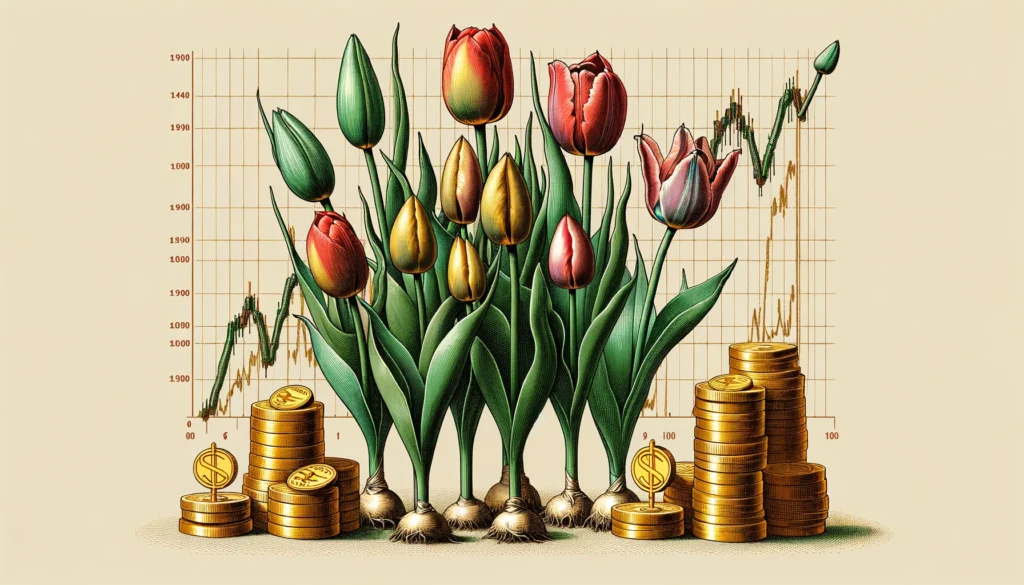To understand what an economic bubble is, let’s imagine a world where a single flower could cost more than a house, only for its value to disappear overnight. This isn’t a fairy tale but a real historical event known as Tulip Mania, which serves as our first lesson in the fascinating and cautionary world of economic bubbles. Through this story and others like it, we can explore how bubbles form, why they burst, and the impact they have on economies and individuals alike.
Understanding Economic Bubbles: A Whirlwind of Wealth and Worry
A bubble in economics occurs when the price of an asset, such as property, stocks, or even flowers, skyrockets far beyond its actual value. This price inflation is fueled by a mix of speculative investment, excitement, and the false belief that selling for a profit will always be possible. However, the bubble is destined to burst when reality sets in, revealing that the inflated prices were unsustainable, leading to a swift and often devastating crash.
“Price is what you pay. Value is what you get.”
– Warren Buffett
The Historic Bloom: Unraveling Tulip Mania
This episode unfolded around the Amsterdam Stock Exchange – now known as Euronext Amsterdam – the world’s oldest stock market, established in 1602. Here, amidst the trading of shares and bonds, the tulip craze found its financial footing, illustrating early on the power of speculation and the chance of big economic trouble caused by investments that appear safe.

The Rise of the Tulip
In the 17th century, the Dutch became fascinated by a luxurious novelty: the tulip, which came from the Ottoman Empire. These flowers quickly turned into a status symbol, showcasing wealth. With their growing popularity, demand skyrocketed, and so did their prices, paving the way for history’s first speculative bubble.
The Peak
Tulip prices reached astronomical levels, with some bulbs trading for the price of a luxurious Amsterdam canal house. The frenzy was fueled by speculative investors, many of whom traded their life savings for bulbs, betting on endless appreciation.
The Burst of the Economic Bubble
However, in 1637, the market realized the absurdity of valuing flowers at such high prices. Almost overnight, demand plummeted, leaving prices to tumble and countless investors facing ruin. The fallout of the first known economic bubble was devastating, affecting the entire Dutch economy and leaving a cautionary tale for the ages.
“The stock market is filled with individuals who know the price of everything, but the value of nothing.”
– Philip Fisher
Notable Economic Bubbles Through History
The South Sea Bubble
In 1720, the South Sea Company, granted a monopoly on trade in the South Seas, promised British investors gold-lined returns. As shares soared, everyone from aristocrats to common folk scrambled to invest. However, when it became apparent that the company’s profits were nowhere near expectations, the bubble burst, leading to widespread financial disaster and a loss of trust in the British financial system.
The Dot-com Bubble
The late 1990s saw the rise of the internet, and with it, a surge in investments in any company with “.com” in its name. Valuations of tech companies reached dizzying heights, often without the profits or business models to support them. The early 2000s brought a harsh return to reality, as the bubble burst and billions in market value evaporated overnight, reshaping the tech industry fundamentally.
The 2008 Housing Bubble
Fueled by low interest rates, easy credit, and speculative buying, U.S. housing prices skyrocketed in the early 2000s. Financial instruments tied to real estate values multiplied., spreading risk across the global financial system. When the bubble burst, it led to a cascade of defaults, bank failures, and the worst economic downturn since the Great Depression, highlighting the dangers of speculative excess and lax regulation.
Navigating Today’s Financial Waters
The tales of Tulip Mania and subsequent economic bubbles offer invaluable lessons. They remind us of the perils of speculative excess and the importance of grounding investment decisions in real value rather than the euphoria of the crowd. As we face new financial innovations and markets, these historical precedents encourage a measured approach, informed by the past as we navigate the uncertain waters of the future.
“Price is temporary, but value is enduring.”
– Howard Marks
Conclusion: A Cycle Repeated
From the tulips of the 17th century to the tech startups of the 21st, the cycle of bubbles and bursts continues to shape our financial landscape. By studying these patterns, we can gain insights into human nature, market dynamics, and the critical balance between speculation and investment. In the realm of finance, history may not repeat itself exactly, but it often rhymes, offering lessons for those willing to listen.
Read more about the stock market and shares here.



